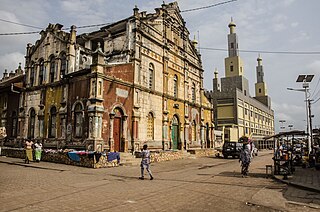Porto-Novo, the official capital of Benin, offers a rich tapestry of culture, history, and natural beauty. Known for its colonial architecture and vibrant markets, the city serves as a living museum of Benin’s diverse heritage. Visitors can explore the Royal Palace, now a museum showcasing artifacts from the kingdom of Porto-Novo. The city is also home to lush gardens, art galleries, and the da Silva Museum of Diaspora, providing insight into the African diaspora. Despite its bustling nature, Porto-Novo retains its charm, making it an essential destination for those interested in the roots and rhythms of African life.
Before visiting Porto-Novo, ensure to check local festivals. Experiencing events like the Vodun Festival can greatly enhance your understanding of the city’s cultural richness.
Consider hiring a local guide when exploring Porto-Novo. Their insights not only enrich your experience but also help navigate the city’s intricate locales and stories.
Top things to do & see in Porto-Novo
Select the following sights and activities to discover best tickets and tours available in Porto-Novo.
Porto-Novo: The Historic Heart of Benin
| Country | Benin |
| Time in Porto-Novo | GMT+1 |
| Language spoken | Fon and French |
| Population | 264,320 (source: World Population Review) |
| Currency | West African CFA franc (XOF ₣) |
| Airports | The main civil airport serving Porto-Novo is Cadjehoun Airport (COO) (20 mi / 32 km). |
Porto-Novo, the capital city of Benin, is a portal to the rich history and cultural heritage of this vibrant West African nation. As the official capital, Porto-Novo houses many of the government institutions, but it is also noted for its historical significance and its cultural contributions to the region. The city is steeped in history, evident from its well-preserved colonial architecture, museums, and vibrant markets that offer a glimpse into the country’s colonial past and its pre-colonial history.
Where is Porto-Novo?
Located in southern Benin, Porto-Novo sits on the Gulf of Guinea, just to the east of the country’s largest city, Cotonou.
Distances:
| Route | Distance by car | Time by car |
|---|---|---|
| Cotonou to Porto-Novo | 35 km | 40 mins |
| Lagos to Porto-Novo | 119 km | 2 hrs 10 mins |
| Accra to Porto-Novo | 405 km | 6 hrs 45 mins |
What is Porto-Novo famous for?
As Benin’s capital, Porto-Novo is renowned for its rich history and vibrant culture. Key attractions include the Royal Palace, the Porto-Novo museum of ethnography, and nearby lakes that are vital for local biodiversity.
History
Pre-Colonial Era (Before 1600)
The region now known as Porto-Novo, the capital of Benin, has a rich historical tapestry that is woven with the threads of several indigenous cultures, primarily the Goun people. It was originally known as Adjatche and functioned as a tributary to the nearby kingdom of Dahomey, which was renowned for its powerful monarchs and vibrant court life.
Colonial Era (1600–1960)
The transformative period for Porto-Novo began in the 16th century when it encountered European traders. The Portuguese, impressed by the natural harbor, named the area Porto Novo which means “New Port”. During this era, Porto-Novo became a vital port in the slave trade, serving as one of the key points from which slaves were exported across the Atlantic. The city was officially declared the capital of French Dahomey during the colonial period, increasing its importance and strategic significance.
Post-Independence (1960–Present)
After gaining independence from France in 1960, Porto-Novo was declared the official capital of Benin, though the seat of government was established in Cotonou. This period marked significant urban and political transformations. The city has since focused on preserving its rich cultural heritage, boasting several museums and historical sites that reflect its extensive historical narrative. Today, Porto-Novo is not only an administrative capital but also a cultural heart of Benin, with ongoing efforts to boost tourism and protect its historical landmarks.
Visit Porto-Novo
What to see and do in Porto-Novo, Benin
Porto-Novo offers a variety of attractions for history buffs and cultural enthusiasts. Notable sites include the Musée Honme (Royal Palace), which provides insights into the royal history of the area, and the Musée da Silva, which showcases Afro-Brazilian history and culture. The city is also home to a vibrant market where visitors can delve into local arts, crafts, and traditional medicine. Nature lovers will appreciate the Jardin Place Jean Bayol, a tranquil park ideal for relaxation.
- Musée Honme (Royal Palace)
- Musée da Silva
- Jardin Place Jean Bayol
- Local markets for arts, crafts, and traditional medicine
Festivals and Events in Porto-Novo
Porto-Novo is vibrant with cultural festivals throughout the year. One of the highlights is the International Voodoo Festival, held annually in January, where participants can experience traditional Voodoo ceremonies. Another significant event is the Porto-Novo Festival of Arts and Culture, taking place every December, celebrating the city’s rich cultural heritage with music, dance, and craft exhibitions.
Best time to visit Porto-Novo
The best time to visit Porto-Novo is between November and February. During these months, the weather is cooler and drier, making it more comfortable for exploring the city and participating in outdoor activities and festivals.
Is Porto-Novo worth visiting?
Porto-Novo, with its rich tapestry of history, culture, and traditions, offers a unique glimpse into the heritage of Benin. The city’s museum, vibrant markets, and beautiful parks make it a worthwhile destination for those interested in history and culture. However, visitors should be prepared for a less touristy experience as most administrative functions have moved to Cotonou, which can affect the availability of certain tourist amenities. Nonetheless, for those who delight in exploring off-the-beaten-path destinations with deep cultural roots, Porto-Novo is certainly worth a visit.








